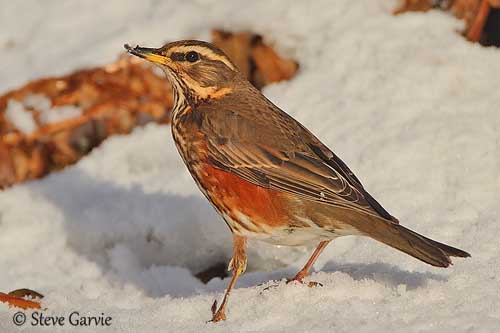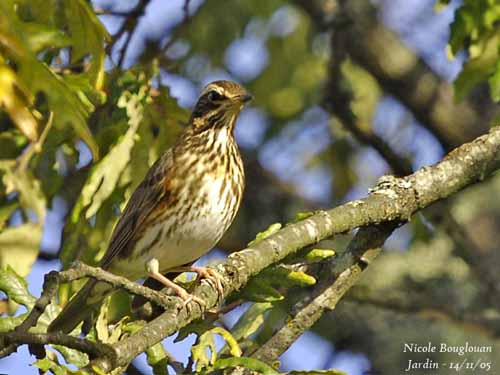
Fr: Grive mauvis
All : Rotdrossel
Esp : Zorzal de Alas Rojas
Ital : Tordo sassello
Nd: Koperwiek
Sd: Rödvingetrast
Photographers:
Steve Garvie
RAINBIRDER Photo galleries
Nicole Bouglouan
PHOTOGRAPHIC RAMBLE
Text by Nicole Bouglouan
Sources:
HANDBOOK OF THE BIRDS OF THE WORLD Vol 10 by Josep del Hoyo-Andrew Elliott-David Christie - Lynx Edicions - ISBN: 8487334725
ENCYCLOPEDIE DES OISEAUX DE FRANCE ET D’EUROPE – de Peter Hayman et Rob Hume - Flammarion – ISBN : 2082009920
THE COMPLETE BOOK OF BRITISH BIRDS – Written by “Royal Society for the Protection of Birds” experts - Préface de Magnus Magnusson - Michael Cady- Rob Hume Editors - ISBN: 0749509112
THE HANDBOOK OF BIRD IDENTIFICATION FOR EUROPE AND THE WESTERN PALEARCTIC by Mark Beaman, Steve Madge - C.Helm - ISBN: 0713639601
THRUSHES by Peter Clement and Ren Hathway – HELM - ISBN: 0713639407
BirdLife International (BirdLife International)
Birds of Britain - The Web Magazine for Birdwatchers
Wikipedia, the free encyclopaedia
Redwing
Turdus iliacus
Passeriforme Order – Turdidae Family
BIOMETRICS:
Length: 20-24 cm
Weight: 40-80 g
DESCRIPTION:
The Redwing is the smallest of the typical thrushes. This migratory bird often visits gardens and bird-feeders during the harsh winters.
The adult has greyish-brown plumage on upperparts and head, where we can see a conspicuous, long, buffy-white supercilium, and more or less distinct malar stripe.
The underparts are buffy-white with orange-rufous flanks and underwing-coverts. Several long streaks are formed with blackish spots. They start from the throat, and continue to breast and body sides.
The bill is black with yellow base. The eyes are dark brown. Legs and feet are pinkish-brown.

Both sexes are similar.
The juvenile resembles adult, but the upperparts are streaked buff and the underparts are heavily spotted with less orange-red on flanks than in adults.
The subspecies T.i. coburni from Iceland and Faeroe islands is darker, browner above and darker spotted below.
VOICE: SOUNDS BY XENO-CANTO
The Redwing’s typical call is a high-pitched and far-carrying “dssssi” or “srieh” note, frequently given as contact call both in flight and on the ground.
In the winter flocks, the contact note is a harsh “zieh” and a short “chup” or “chittick”, also given when the birds are going to roost.
The alarm call is a series of sharp rattling “trrrt trrrt trrrt” and also shorter, sharp “jipp jipp”.
The song includes two parts or more. It starts with a few short flute-like notes, followed by faster twittering variable in length and pitch.
The migrating flocks utter a low twittering chorus, also heard on the wintering grounds.
The Redwing may sing by night, especially in the northern parts of the range. The male sings from prominent high perch.
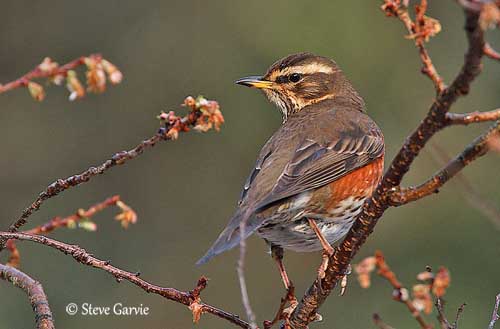
HABITAT:
The Redwing breeds in forest, mainly in birch or mixed conifer woodland in lowland, along river valley, floodplains and edges of wet areas.
During the migration, this species can be found anywhere along coasts or on hilltops. During winter, they occur in woods, hedgerows and more open fields, pastures, city parks, gardens and orchards.
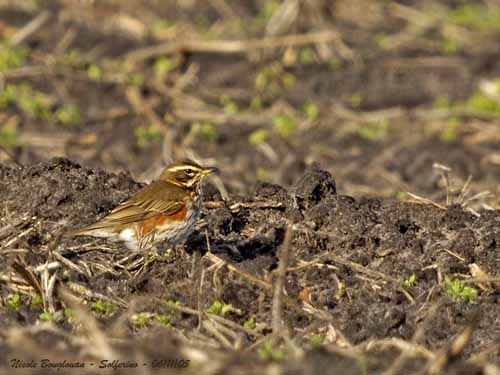
RANGE:
The Redwing of race “coburni” occurs in Iceland and Faeroe islands. It winters in W Europe.
The race “iliacus” is found in N and E Europe, E across Siberia to Kolyma and Altai. This one migrates in W and S Europe, North Africa, Black and Caspian Sea basins and adjacent SW Asia.
They migrate by night in loose but large flocks. The travelled distance depends on weather conditions.
BEHAVIOUR:
The Redwing feeds on wide variety of invertebrates, including some aquatic crabs and worms found along the tideline. It also consumes seeds, fruits and berries in autumn and winter.
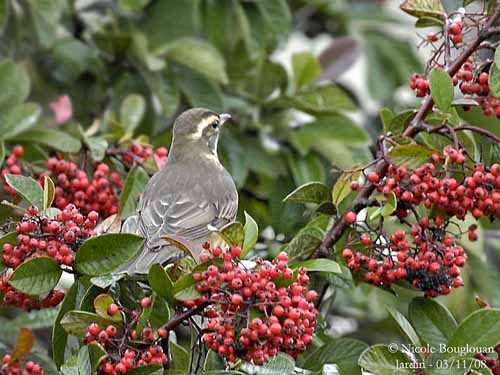
The Redwing forages on the ground, but also in trees and bushes. It takes food from the ground surface, and may occasionally dig for earthworms as the Songthrush does. The shells of snails are broken against rocks or stones used as anvils.
They spend the night at communal roost in winter, gathering in large flocks in woods, thickets, plantations and old hedgerows. They often share the roost with other species such as Fieldfares and starlings.
During the breeding season, the male sings from exposed perches to establish the territory.
VOL:
The Redwing has undulating flight with short glides, especially on migration.
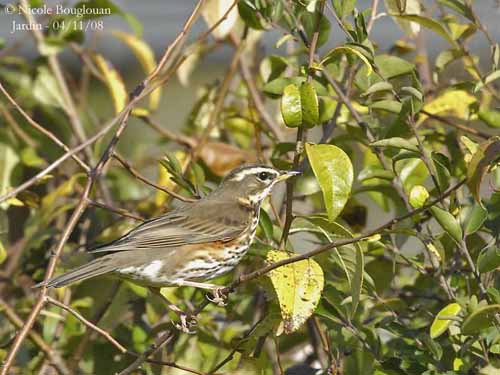
REPRODUCTION:
The breeding season occurs between early April and late July, but it may vary in Iceland where it starts only in mid-May.
The Redwing is usually solitary but sometimes, several nests may form loose colonies. The nest is placed on the ground, concealed in the dense vegetation, or in low tree or bush, or even on rotten stump.
The bulky cup is made with grass, moss and twigs, bound with mud and pieces of plants. The lining is made with finer grass, stems and leaves.
The female lays 4-6 pale blue eggs with fine reddish-brown markings. The incubation lasts about 10-14 days, usually only by female. The chicks are fed by both adults. They fledge 12-15 days after hatching, and still depend on the male for food for two weeks, while the female initiates a second clutch.
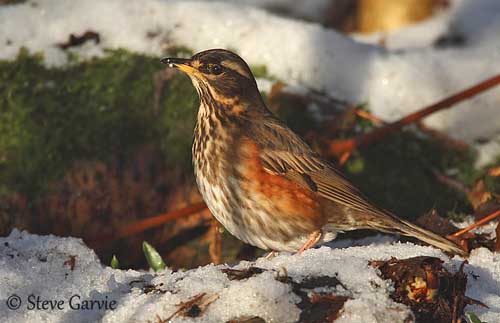
DIET:
The Redwing feeds on wide variety of invertebrates such as adult and larvae Coleopterans and several types of Hymenopterans, flies, caterpillars, bugs, crickets, dragonflies and mayflies. It also takes spiders, small crabs and molluscs, earthworms and marine worms.
During autumn and winter, it also consumes fruits, berries and seeds.
The Redwing forages mainly on the ground and in low bushes.
PROTECTION / THREATS / STATUS:
The Redwing is usually common, with numbers locally variable due to harsh winters.
The species is not currently threatened.
